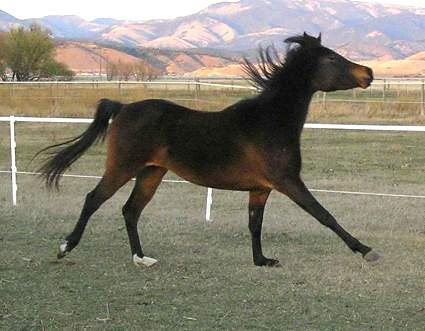Cerebellar Abiotrophy Lisa Goodwin-Campiglio, Drs. Gerber and Leeb Cerebellar abiotrophy (CA) also referred to as cerebellar cortical abiotrophy (CCA) is a genetic neurological disease in animals best known to affect certain breeds of horses and dogs. It develops when neurons known as Purkinje cells in the cerebellum of the brain begin die off. These cells affect balance and coordination. They have a critical role to play in the brain. The Purkinje layer allows communication between the cortical layers in the cerebellum. Put simply, without Purkinje cells, an animal loses its sense of space and distance, making balance and coordination difficult. In most cases, the neurons begin to die off shortly after the animal is born and the condition is noticable when the animal is less than six months old, though sometimes the onset of symptoms is gradual and the animal is much older before the owner or caretaker notices a problem. CA cannot be prevented, other than by selective breeding to avoid the gene, and it cannot be cured. In addition to dogs and horses, there also have been cases of cerebellar abiotrophy in Siamese Cats; in Angus, Polled Hereford, Charlois and Holstein Friesian cattle; Merino and Wiltshire sheep; and Yorkshire pigs. Cerebellar abiotrophy in horses was originally thought to be a form of cerebellar hypoplasia and was described as such in older research literature. The condition in Kerry Blue Terriers is sometimes called progressive neuronal abiotrophy (PNA). There are diseases that cause other types of cerebellar degeneration, but the loss of Purkinje cells is a clear way to diagnose CA, and the combination of symptoms is sufficiently unique that CA is unlikely to be confused with other conditions. Symptoms of cerebellar abiotrophy include ataxia or lack of balance, an awkward wide-legged stance, a head tremor (intention tremor) (in dogs, body tremors also occur), hyperreactivity, lack of menace reflex, stiff or high-stepping gait, coarse or jerky head bob when in motion (or in very young animals, when attempting to nurse), apparent lack of awareness of where the feet are (sometimes standing or trying to walk with a foot knuckled over), poor depth perception, and a general inability to determine space and distance. The symptoms are, when taken as a group, fairly unique and not easily mimicked by other illnesses, though certain types of neurological injury and infection do need to be ruled out. However, verifying the diagnosis in terms of laboratory evidence is only possible by examining the brain post-mortem to determine if there has been a loss of Purkinje cells. Most affected animals have normal intelligence and mildly affected animals can, in theory, live out a normal lifespan. However, affected animals are accident-prone, and for this reason many affected animals, particularly horses, are euthanized for humane reasons. Dogs may need lifetime assistance with tasks such as climbing stairs. Horses may experience difficulty stepping up and over objects, run into fences, fall easily, and even if allowed to mature to full growth, are generally considered unsafe to ride. In horses, the symptoms may worsen from the time of onset for six to 12 months, but if not severe enough to mandate euthansia, they stabilize over time. In some dog breeds, symptoms appear to progressively worsen, but research is not consistent on this point. There also is some evidence that affected animals partially compensate for the condition by cognitively learning alternative methods for moving or to determine distance, and thus appear to improve because they become less accident-prone. Cerebellar abiotrophy (CA) is best known as a condition affecting Arabian horses. It has also been observed in the Miniature horse, the Gotland Pony, and possibly the Oldenburg. Most foals appear normal at birth, with symptoms noticable at an average age of four months, though there have been cases where the condition is first observed shortly after birth and other cases where symptoms are first recognized in horses over one year of age. In horses, CA is believed to be linked to an autosomal recessive gene. This means it is not sex-linked, and the gene has to be carried by both parents in order for an affected animal to be born. Horses that only carry one copy of the gene may pass it on to their offspring, but themselves are perfectly healthy--without symptoms of the disease. There currently is no DNA test for CA in horses, though there is ongoing research at the Veterinary Genetics Laboratory at the UC Davis School of Veterinary Medicine.  Photo by BLW A two-year-old Arabian horse with cerebellar abiotrophy, showing stiff awkward gait, and upper range of unnatural head bob. Though this horse has a relatively mild case, it cannot ever be ridden. |
If you would like to have an article included in this section then please send your article to webmaster@arabianlines.com